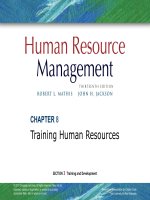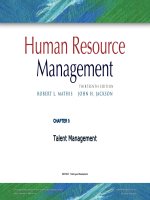Human resrouce management 13th mathis jacson chapter 09
Bạn đang xem bản rút gọn của tài liệu. Xem và tải ngay bản đầy đủ của tài liệu tại đây (1.81 MB, 35 trang )
CHAPTER 9
Talent Management
SECTION 3 Training and Development
©
© 2011
2011 Cengage
Cengage Learning.
Learning. All
All rights
rights reserved.
reserved. May
May not
not be
be scanned,
scanned, copied
copied or
or duplicated,
duplicated, or
or posted
posted to
to aa
publicly
publicly accessible
accessible Web
Web site,
site, in
in whole
whole or
or in
in part.
part.
PowerPoint
PowerPoint Presentation
Presentation by
by Charlie
Charlie Cook
Cook
The
The University
University of
of West
West Alabama
Alabama
Chapter Objectives
After you have read this chapter, you should be able to:
•
Identify the importance of talent management and discuss two reasons it may be difficult.
•
Explain what succession planning is and its steps.
•
Differentiate between organization-centered and individual-centered career planning.
•
Discuss three career issues that organizations and employees must address.
•
List options for development needs analyses.
•
Identify several management development methods.
© 2011 Cengage Learning. All rights reserved. May not be scanned, copied or duplicated, or posted to a publicly accessible Web
site, in whole or in part.
9–2
What Is Talent Management?
• Talent Management
Concerned with enhancing the attraction, long-term development, and retention of key
human resources
© 2011 Cengage Learning. All rights reserved. May not be scanned, copied or duplicated, or posted to a publicly accessible Web
site, in whole or in part.
9–3
Why Talent Management Is Needed
•
Impending retirement of experienced baby boomers
•
A shortage of young people entering the workforce
•
High school graduates who lack writing and verbal communication skills, as well as a work ethic
•
College graduates with weak writing, leadership, critical thinking, and creativity skills
•
Companies unprepared for a sudden loss of leadership
•
Lack of accountability for managers and executives in developing their direct reports
© 2011 Cengage Learning. All rights reserved. May not be scanned, copied or duplicated, or posted to a publicly accessible Web
site, in whole or in part.
9–4
Nature Of Talent Management
Creating and maintaining an
Identifying future needs and
organizational culture that values
developing individuals to fill those
people
needs
Key Areas
of Talent Management
Establishing ways to conduct and
manage activities to support talent
development
Developing a pool of talented people
who can supply future job needs
© 2011 Cengage Learning. All rights reserved. May not be scanned, copied or duplicated, or posted to a publicly accessible Web
site, in whole or in part.
9–5
Talent Management in Perspective
Target
Jobs
Competency
High-Potential Individuals
Models
Scope of
Talent Management
Talent
Assessment and Career Tracks
Pools
Development
Risk Sharing
© 2011 Cengage Learning. All rights reserved. May not be scanned, copied or duplicated, or posted to a publicly accessible Web
site, in whole or in part.
9–6
FIGURE 9–1
Talent Management
© 2011 Cengage Learning. All rights reserved. May not be scanned, copied or duplicated, or posted to a publicly accessible Web
site, in whole or in part.
9–7
FIGURE 9–2
Succession Planning
Process
© 2011 Cengage Learning. All rights reserved. May not be scanned, copied or duplicated, or posted to a publicly accessible Web
site, in whole or in part.
9–8
HR’s Role in Succession Planning
Identifying development needs of the workforce
Assisting in identifying needed future job skills
Noting employees who might fill future positions
Succession Planning
Communicating the succession planning process to
employees
Tracing and regularly updating succession plan efforts
© 2011 Cengage Learning. All rights reserved. May not be scanned, copied or duplicated, or posted to a publicly accessible Web
site, in whole or in part.
9–9
Succession Planning Decisions
Potential versus Performance
Succession
“Make or Buy” Talent
Succession Planning Metrics
Planning Considerations
Computerized Succession
Planning Models
© 2011 Cengage Learning. All rights reserved. May not be scanned, copied or duplicated, or posted to a publicly accessible Web
site, in whole or in part.
9–10
Succession
Planning Process
© 2011 Cengage Learning. All rights reserved. May not be scanned, copied or duplicated, or posted to a publicly accessible Web
site, in whole or in part.
9–11
FIGURE 9–3
Assessing Potential and Current
Performance
© 2011 Cengage Learning. All rights reserved. May not be scanned, copied or duplicated, or posted to a publicly accessible Web
site, in whole or in part.
9–12
Values and Benefits of Succession Planning
•
•
Having an adequate supply of employees to fill future key openings
Providing career paths and plans for employees, which aids in employee
retention and performance motivation
•
•
Continually reviewing the need for individuals as organizational changes occur
Enhancing the organizational “brand” and reputation as a desirable place to
work
© 2011 Cengage Learning. All rights reserved. May not be scanned, copied or duplicated, or posted to a publicly accessible Web
site, in whole or in part.
9–13
Common Succession Planning Mistakes
•
•
•
•
•
Focusing only on CEO and top management succession
Starting too late, when openings are occurring
Not linking well to strategic plans
Allowing the CEO to direct the planning and make all succession decisions
Looking only internally for succession candidates
© 2011 Cengage Learning. All rights reserved. May not be scanned, copied or duplicated, or posted to a publicly accessible Web
site, in whole or in part.
9–14
Careers and Career Planning
• Career
The series of work-related positions a person occupies through
life.
• Career Paths
Represent employees’ movements through opportunities over
time.
© 2011 Cengage Learning. All rights reserved. May not be scanned, copied or duplicated, or posted to a publicly accessible Web
site, in whole or in part.
9–15
Different Views of Careers
Individual Career
Views
Protean career
Career without
boundaries
Portfolio career
Authentic career
© 2011 Cengage Learning. All rights reserved. May not be scanned, copied or duplicated, or posted to a publicly accessible Web
site, in whole or in part.
9–16
Careers and Career Planning (cont’d)
• Organization-Centered Career Planning
Focuses on jobs and on identifying career paths that provide for the logical progression of
people between jobs in the organization.
• Individual-Centered Career Planning
Focuses on an individual’s career rather than in organizational needs.
© 2011 Cengage Learning. All rights reserved. May not be scanned, copied or duplicated, or posted to a publicly accessible Web
site, in whole or in part.
9–17
FIGURE 9–4
Organizational and Individual Career Planning Perspectives
© 2011 Cengage Learning. All rights reserved. May not be scanned, copied or duplicated, or posted to a publicly accessible Web
site, in whole or in part.
9–18
Individual-Centered Career Planning
Individual Career Management
Self-Assessment
Feedback
Setting of
on Reality
Career Goals
© 2011 Cengage Learning. All rights reserved. May not be scanned, copied or duplicated, or posted to a publicly accessible Web
site, in whole or in part.
9–19
Individual Career Choices
Career Choice
Interests
Self-Image
Personality
Social Background
© 2011 Cengage Learning. All rights reserved. May not be scanned, copied or duplicated, or posted to a publicly accessible Web
site, in whole or in part.
9–20
FIGURE 9–5
General Career Periods
© 2011 Cengage Learning. All rights reserved. May not be scanned, copied or duplicated, or posted to a publicly accessible Web
site, in whole or in part.
9–21
FIGURE 9–6
Portable Career Path
© 2011 Cengage Learning. All rights reserved. May not be scanned, copied or duplicated, or posted to a publicly accessible Web
site, in whole or in part.
9–22
Career Transitions and HR
Entry Shock for New
Employees
Supervisors
Feedback
Time
The Work
© 2011 Cengage Learning. All rights reserved. May not be scanned, copied or duplicated, or posted to a publicly accessible Web
site, in whole or in part.
9–23
Special Individual Career Issues
Women and Careers
Technical and Professional Workers
Sequencing
Dual Career Ladders
Glass Ceiling
Special Individual
Career
Issues
Global Career Concerns
Dual-Career Couples
Repatriation
Family-Career Issues
Global Development
Relocation
© 2011 Cengage Learning. All rights reserved. May not be scanned, copied or duplicated, or posted to a publicly accessible Web
site, in whole or in part.
9–24
Developing Human Resources
• Development
Efforts to improve employees’ abilities to handle a variety of assignments and to cultivate
employees’ capabilities beyond those required by the current job.
• Developing Specific Capabilities/Competencies
Lifelong learning
Redevelopment
© 2011 Cengage Learning. All rights reserved. May not be scanned, copied or duplicated, or posted to a publicly accessible Web
site, in whole or in part.
9–25









